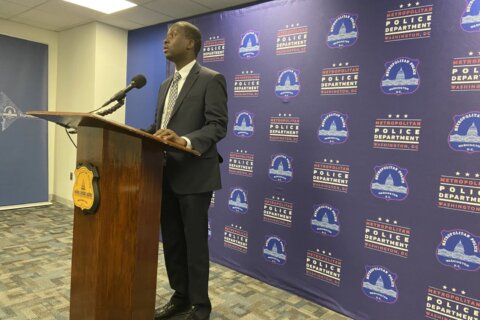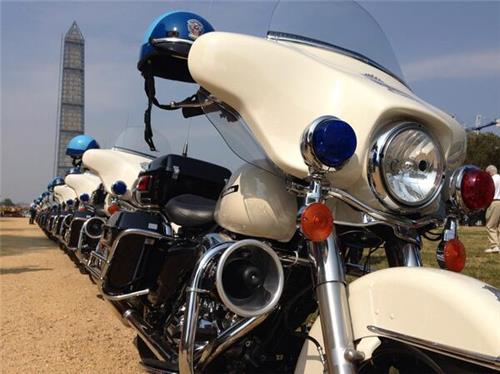Last June, amid protests in D.C., police penned demonstrators into a block of Swann Street in Northwest D.C., arresting and pepper-spraying those out past curfew and leading residents to take others into their houses while police roamed outside trying to make more arrests.
A new report claims D.C. police used tactics that escalated the situation, and calls on the D.C. Council to reconsider the rules under which police operate in such situations.
The report from the American Civil Liberties Union of D.C., the Washington Lawyers’ Committee for Civil Rights and Urban Affairs and Sidley Austin LLP, was compiled from more than 50 interviews with protesters and residents who took them into their homes, as well as photos and video footage of the night in question.
“Based on this review,” the report said, “we have identified multiple serious questions raised by MPD’s actions that night and the potential need for improved guidance from the people’s representatives on the proper means for responding to peaceful First Amendment assemblies.”
Noting that the people who were kettled and arrested on Swann Street were charged only with curfew violations, the report said, the police could have given protesters the option to simply go home, fulfilling the purpose of the curfew. Many protesters who were trapped on the block asked permission to do that, according to the report — but the police didn’t give them that option.
“Given the absence of support for more serious charges, MPD could and should have acted with greater restraint on Swann Street,” the report said. “The Council should consider whether D.C. law or policy should be changed to promote a more restrained police response to peaceful protests in the District.”
White House protest
The protests in D.C. in late May and early June were in reaction to the death of George Floyd at the hands of Minneapolis police. The report notes that there was some vandalism and arson surrounding the mostly peaceful protests two nights before; in response, D.C. Mayor Muriel Bowser imposed a curfew. On the night of June 1, it went into effect at 7 p.m.
At about 6:30 p.m., the protesters in Lafayette Square, across from the White House, were violently cleared from the area so that then-President Donald Trump could pose for a photo in front of St. John’s Church, where a small fire had been set the night before. From there, they and protesters from other areas of the District joined up.
Witnesses interviewed for the report said lines of police officers and vehicles blocked protesters’ way up 14th Street Northwest, and that flashbang grenades turned them back. Eventually they were funneled onto Swann Street Northwest, and between 8:30 and 9 p.m., about 200 were “kettled” onto the block between 14th and 15th streets, with each end of the block sealed off by police and side streets also rendered impassable.
From there, police began to pepper-spray protesters, some of whom took up offers of shelter from residents of the street. At about 10 p.m., the arrests began, the report said, with protesters being taken to the convention center, then to the police academy in Southwest.
Officers continued to prowl Swann Street until about 4 a.m. June 2. The report claims that police used various tactics, including deception, to lure protesters out of houses to be arrested. The curfew was lifted at 6 a.m.
WTOP’s Ken Duffy was one of the people who spent the night in a house on Swann Street. He called the protesters he saw “absolutely peaceful.” You can read his account.
Police union response
Gregg Pemberton, the chairman of the D.C. police union, responded in a statement that the ACLU in its report “has left out all the pertinent facts in order to advance their anti-police agenda.”
He claimed, “The incident on Swann Street involved violent and riotous activity including cars set afire and bricks thrown at officers,” as well as 911 calls from residents saying protesters were kicking at their front doors.
The ACLU report mentions social media posts related to the alleged burning of a police car, saying that it was at 14th and Clifton streets, north of where the northward-marching protesters were turned back. No protesters arrested on Swann Street were charged with anything other than violating curfew.
Pemberton added that neither the Office of Police Complaints, the Use of Force Review Board, the U.S. Attorney’s Office nor the police’s Internal Affairs Division found any misconduct in their investigations.
“Our officers acted professionally and appropriately to protect the city and the community,” Pemberton said. “This is just another contrived effort by the ACLU to achieve their goals of defunding police.”
Recommendations
The report claims the police tactics were unnecessary given the relatively minor nature of standalone curfew violations, and says various tactics “exacerbated the risk” to police and protesters of exposure to COVID-19.
The report asks the D.C. Council to ask why the police didn’t give protesters the chance to disperse; on what grounds the police believed the protest could turn violent; what measures were in place to protect people from coronavirus exposure, and whether the treatment of those arrested was unnecessarily rough.
Among the specific recommendations: an examination of kettling tactics in the context of curfew orders, which the report claims inherently leave large groups of peaceful people subject to mass arrest; and a change that would require police to try to disperse “unlawful but non-violent” assemblies before trying to arrest anyone. The current law, the First Amendment Assemblies Act, merely “expresses a preference” for dispersal.
The report concludes, “there is work for the Council to do to ensure MPD has appropriate legal and policy guidance and always responds with appropriate restraint to peaceful assemblies, and we urge the Council to take up that task with urgency as it continues to oversee MPD’s work.”








